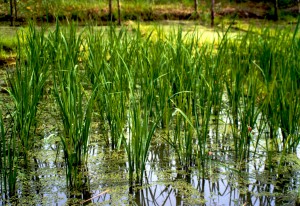Researchers from PhilRice discovered that growing of azolla is an alternative way to minimize golden apple snail (GAS) damages in transplanted rice. 
Dindo King Donayre, lead researcher, said that growing azolla together with rice will divert the appetency of GAS away from the newly-established rice.
“The amount of missing seedlings is significantly reduced up to 89.2% per square meter with an average of 60 snails per square meter,” Donayre said.
The golden apple snail, popularly known as “golden kuhol” is one of the major rice pest problems in the farm. Data from PhilRice estimated that yield losses owing to this pest ranged up to 40%, resulting to huge production loss. 15-day old transplanted rice seedlings and 4-to-30-day-old direct seeded rice are their most vulnerable targets as a source of food.
GAS can lay up to 1200 eggs monthly. To control this pest, most farmers resort to synthetic molluscicides that are expensive and have broad spectrum, affecting even the non-target organisms including the farmers themselves.
On the other hand, azolla (duckweed fern/fairy moss/water fern) is known for its nitrogen-fixing capability and is widely used as a biofertilizer reducing farmers’ expenses on synthetic fertilizers. As a free-floating aquatic plant, it also serves as an alternative food of GAS in the absence of rice.
Through the course of the study, azolla is introduced on the rice field 10 days after transplanting. GAS were also placed at different population levels throughout the experiment area. Data on missing rice seedlings were gathered daily for 7 consecutive days.
“At varying water levels and GAS population per square meter, we noted a significant decrease of missing seedlings,” Donayre explained.
At 1 cm water level, the decrease ranged from 84.3%- 89.2%, and at 2-3 cm the rate of decrease ranged from 65.3%- 77.6%, all from 30 to 90 GAS population per square meter.
“It is a natural way of GAS management,” Donayre said.
He noted that aside from being an alternative method to nutrient management, growing of azolla is also an effective, economical, and environment-friendly way of managing GAS.
For more information about the benefits of growing azolla, call or text the PhilRice Text Center 0920 911 1398.




